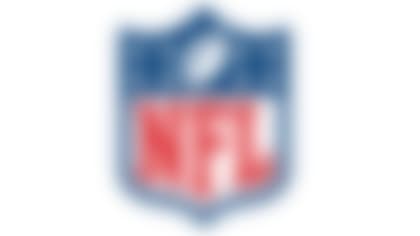EARTH CITY, Mo. -- The cluster of remaining draft cards magnetically affixed to the St. Louis Rams' draft board Friday night formed the shape of a partial football helmet, with so many offensive linemen sharing the same, second-round rating that some of their cards spilled over into other columns. And given that the Rams were closing in on their second-round selection and were, in fact, planning to pick an offensive lineman, coach Jeff Fisher and general manager Les Snead had a decision to make -- one which, in essence, had been resolved by the many months' worth of work that had preceded the 2015 NFL Draft.
As Fisher, Snead and COO Kevin Demoff huddled in the team's crowded war room to affirm their strategy, secondary coach Brandon Fisher gestured toward his father and explained, "He's thinking 'trade down,' because the board is talking to us. If you have a bunch of players who you basically rate the same, and you're happy to get any one of them, then moving down is the smart play."
If trading down was the call, seldom had a message rung so loudly and clearly in real time. About five seconds after the Rams were on the clock for the 41st overall selection, the Kansas City Chiefs called with an offer -- and five other teams followed suit shortly thereafter. After a furious, five-and-a-half minute stretch of constant communication, Fisher, Snead and Demoff finalized a deal with the Carolina Panthers, moving down 16 spots in the second round while snagging extra picks in the third and sixth rounds.
As it turned out, the Rams would get linemen from the aforementioned cluster in the second and third rounds -- and would reinforce a lesson in effective war-room strategy.
Despite all of the over-amplified analysis that precedes the draft, and the ridiculously premature proclamations of success and failure which immediately follow it, the ultimate purpose of these player selections should not be to curry media and fan approval. For the people in the business of building a winning football team, affection and emotion are often the enemies. Over the long haul, cold-hearted calculation and pragmatism typically yield much more fruitful results.
"People fall in love in the second round," Snead told me a few minutes after the trade-down frenzy, as he and Fisher rebooted and waited to see which players would still be on the board when the 57th pick arrived. "If you're not in love, you're in the driver's seat. Last year, we fell in love with (defensive back Lamarcus) Joyner, and we gave up a '5' to move up to get him. This year, we were able to go the other way."
While the 2014 selection of Joyner in the second round carried an entertaining subtext that concerned Fisher one-upping the franchise that formerly employed him, there's a compelling sense of satisfaction that comes from allowing the draft board to guide your decisions. Doing so isn't as easy as it sounds, for the prolonged, intensified nature of the scouting process inevitably leads to attachment -- and the compressed time frame between picks lends itself to frantic, hair-trigger decisions.
"It's hard not to fall in love if you're passionate about players and the draft," Indianapolis Colts general manager Ryan Grigson conceded Sunday. "But if that player comes off early, you better shake it off and hit the reset button in a hurry in that room, so you don't miss out on the next-best opportunity for your organization."
Having spent time in the Rams' war room in three of the last four drafts, and after having been afforded an up-close-and-personal view of the Jacksonville Jaguars' draft room during Thursday night's first round, I've acquired a greater appreciation of how difficult it is to block out the noise (sometimes even literal noise, from within the room itself) and remain businesslike and pragmatic during the process.
I know this because there have been times, after hearing coaches and personnel executives laud a particular prospect in the months preceding the actual event, when even I have felt emotionally invested in that prospect joining a team in question. When it doesn't happen -- or, when making it happen turns out not to be the most logical play -- moving on and letting go isn't always easy.
This is especially true for first-time general managers, many of whom must fight off the natural tendency to try to swing for the fences, when sometimes opposite-field singles are the smart play.
"That's why you have player personnel directors and college (scouting) directors -- to give voices of reason and perspective," San Diego Chargers general manager Tom Telesco said, a day after presiding over his third draft.
And it's also why, during a seemingly endless succession of meetings, pro-day visits, private workouts and other pre-draft preparation, mapping out as many scenarios as possible is an advisable approach.
"You put in the work, and at some point you decide who ranks where, and you try to stay true to that," Jags owner Shad Khan explained a couple of hours before Thursday's first round commenced. "Dave (Caldwell, the Jags' third-year GM) is really good about going over different possibilities, and trying to play them out, so that we're as prepared as we possibly can be if things come up and suddenly we're on the clock."
Picking third on Thursday, and with quarterbacks Jameis Winston and Marcus Mariota almost certain to be selected first and second, Caldwell -- who'd used the third overall selection a year ago on quarterback Blake Bortles -- knew he'd have a chance to draft the top player on his board, versatile pass rusher Dante Fowler Jr. Having decided there were four other players he regarded as potential difference-makers of the same magnitude (defensive tackle Leonard Williams, receivers Amari Cooper and Kevin White and defensive end Vic Beasley), Caldwell was willing to listen if a team picking fourth through seventh sought to move up and swap first-round picks.
Ideally, Caldwell hoped, one of those teams' general managers would reach out, putting him in a position of perceived power. "It's definitely better if you're not the one to call first," Caldwell told me Wednesday night, "but at this point, I feel like if they were going to call, there would have been some groundwork done already. When I was in Atlanta, Thomas (Dimitroff, the Falcons' GM) talked to Cleveland about potentially trading up (in the 2011 draft) weeks in advance -- and that made it a smoother process on draft night, when he moved up and got Julio Jones."
Caldwell was right -- none of the teams holding picks four through seven (the Raiders, Redskins, Jets and Bears) called on Thursday, so he bit the bullet and contacted each of their general managers, to no avail. That made picking Fowler an easy and obvious endeavor, but even after he placed the call to the gaudily attired player and provoked a hearty round of applause in the Jags' war room, he started preparing for the next scenario.
In addition to securing a potential game-changer as an edge rusher, coach Gus Bradley really wanted a running back. Had either of the top two backs on the Jags' draft board, Todd Gurley or Melvin Gordon, still been around after the 20th overall selection, Caldwell was prepared to try to move up to grab one, packing Jacksonville's second-round pick (36th overall) with other selections. The price, he believed, might come as cheap as a third-round pick, possibly even next year's.
However, the Rams grabbed Gurley with the 10th pick, and Telesco traded up to get Gordon five spots later, meaning Caldwell could relax for the rest of the round. As an eclectic mix of music livened up the war room, with selections ranging from Eazy-E's "Boyz-n-the-Hood" to the Grateful Dead's "Sugar Magnolia" to Ozzy Osbourne's "Crazy Train" (Caldwell got some stares after deadpanning, "I Love AC/DC!" during the first notes of the latter track), he watched the final picks play out.
By round's end, four players ranked at the top of his board, and he said he felt equally comfortable picking any of them. Given that the Jags held the fourth pick of the second round, they were in a great spot.
"But we really gotta get (T.J.) Yeldon if he's there," Bradley said, referring to the former Alabama running back.
"We'll see," Caldwell said -- perhaps trying to preclude the possibility of his intentions being leaked to outsiders, or possibly firming up the don't-fall-in-love philosophy that he, too, espouses.
"Options are good," Caldwell later explained. "It gives you a lot of flexibility. It allows you to take advantage of a trade opportunity, too."
And sure enough, a few minutes after the first round's conclusion, Snead (whom Caldwell succeeded as Dimitroff's right-hand man in Atlanta) called to offer a deal: The 41st overall selection and running back Zac Stacy, in exchange for the Jags' 36th pick. Stacy, made expendable by the selection of Gurley, had a productive rookie campaign in 2013 before being pushed into a lesser role last season.
Most likely, Caldwell was just having fun at my expense. I got the sense that he was open to trading down, though not for Stacy -- and also that, if Yeldon was gone by the time the Jags got on the clock, he'd be even more receptive to dealing the pick.
The next night, while monitoring the situation from inside the Rams' war room, I wasn't surprised when the Jags turned in the card for Yeldon.
Happy coach, happy life.
The draft is far from an exact science, and I resolutely believe that people in my business -- and a growing number of consumers -- tend to exaggerate its importance and pontificate prematurely. Personally, while I'm not averse to evaluating a given team's draft process (i.e. "They wanted to reshape the secondary, and they aggressively made moves to go get the players they targeted ..."), I have a longstanding rule against instant-draft analysis, and I ignore anyone else's (with the exception of professional talent evaluators whose opinions I trust).
Yet the more time I spend in draft rooms, the greater the respect I develop for the general managers and coaches who stay true to their core philosophies, even -- and especially -- in the heat of the moment.
Late Thursday night, Grigson chose Miami wide receiver Phillip Dorsett with the 29th overall selection, provoking an immediate chorus of ridicule and dissent on social media, blogs and other platforms. Critics complained that the swift, diminutive Dorsett merely gave the Colts a second helping of T.Y. Hilton, their leading receiver from 2014, and that the pick had done nothing to shore up Indy's biggest weaknesses, such as a defensive unit that surrendered 45 points to the Patriots in the AFC Championship Game.
Since I tend to be a strong advocate of Grigson's body of work, I started texting some of the talent evaluators around the league I respect most to solicit their opinions, and also asked some people in the Jags' war room.
The replies I got were overwhelmingly positive about the pick: "Grand slam!!!" was one scout's response.
I also texted Colts owner Jim Irsay, the man whose opinion of Grigson's pick will ultimately matter most. Granted, Irsay wasn't likely to express displeasure in the wake of the selection, but he could easily have chosen not to reply, or to say something generic and let the situation play out for itself.
Instead, he sent a voice memo, which I received well after midnight, after getting off the phone with the NFL's after-hours travel department to book a flight to St. Louis.
The message lasted more than a minute, and the excitement in Irsay's voice was palpable and infectious. He said a lot of glowing things about Dorsett, and he insisted that the pick had been an easy one. Seven words in particular stayed with me.
We let the board talk to us.
Follow Michael Silver on Twitter @MikeSilver.




